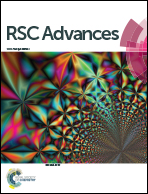Ultrasound-assisted C–C coupling reactions catalyzed by unique SPION-A-Pd(EDTA) as a robust nanocatalyst
Abstract
A novel and highly stable Pd(EDTA)2− salt was synthesized as a catalyst, using a counter-cation of N-methylimidazolium bonded to 1,3,5-triazine-tethered SPIONs (superparamagnetic iron oxide nanoparticles). This well-defined complex efficiently catalyzed the Mizoroki–Heck and Suzuki–Miyaura cross-coupling reactions. The cross-coupled products were produced under conventional heating and ultrasound irradiation at an extremely low catalyst loading (as low as 0.032 mol% Pd). Results indicated that conventional synthesis took longer and gave moderate yields, while in the presence of ultrasound irradiation, the reaction occurred very fast in high to excellent yields. The catalyst could be quickly recovered by an external magnetic field and could be reused for several reaction cycles without any change in catalytic activity.


 Please wait while we load your content...
Please wait while we load your content...